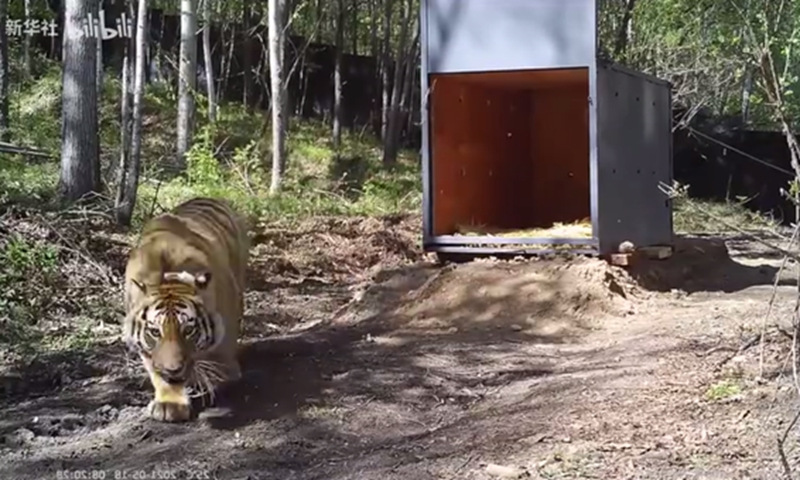
Photo: Screenshot of Xinhua video
A
Siberian tiger rescued in Northeast China has been released into the wild on Tuesday with a collar to trace its displacement, hunting grounds and to avoid contact with humans.
Experts said it was the first time China has successfully rescued and released a wild Siberian tiger. The health evaluation conducted by experts found that the tiger was in a completely normal physical condition and they decided it should be released as soon as possible.
The Xinhua News Agency shows a video of the tiger walking out of the cage and wandering around for a while before disappearing.
The collar put on the Siberian tiger before its release is used to trace its movements and determine how much space is enough for a Siberian tiger to hunt for food. Certainly, it is also a method to prevent any accidental injuries on villagers as it may stray into residential areas, Cui Yan, director of the wildlife rescue and breeding center at Lesser Khingan Mountains, in Heilongjiang Province, told the stdaily.com.
The tiger was released in Muling, Heilongjiang, next to the China - Russia border, where it has a more complete food supply and a better habitat, according to the report.
The tiger was reported to have walked into a village in Heilongjiang and attacked a resident who was later rescued, before it was taken away by the Heilongjiang Forestry and Grassland Bureau. It was then sent to a local rescue and breeding center, according to media reports.
The big cat is believed to be a 2-year-old juvenile male tiger weighing 225 kilograms, said the media reports.
Siberian tigers, also known as Amur tigers, mainly live in eastern Russia, northeastern China and northern parts of the Korean Peninsula. No more than 500 Siberian tigers are believed to live in the wild, including around 20 in China.
"China is the habitat of the most tiger subspecies and it is the birthplace of all tigers. Effective protection of tigers is of great meaning to both China and the safety of the world's ecosystem," Cui Yan said.
From rescue to the release, the procedure demonstrates China's achievements in wildlife protection as well as development in research and wildlife protection, Cui noted, adding that some other wild animals, like bears and wolfs, have also been spotted in Heilongjiang. This indicates that wildlife is reproducing well under the protection of China's forestry system.
According to Cui, Russian President Vladimir Putin launched a project in 2015 on the border with China to release Siberian tigers into the wild. So far, tigers under the project have started to reproduce and formed a stable population of 15 tigers, which often hunt for food around China's Xiaoxinganling Mountain.
Cui suggested that the national authority needs to expand the protected area for Siberian tigers and leopards.
According to media reports, authorities have made proposal at the national level to build a base for training and releasing of Siberian tigers in the Xiaoxinganling Mountain in Heilongjiang.




